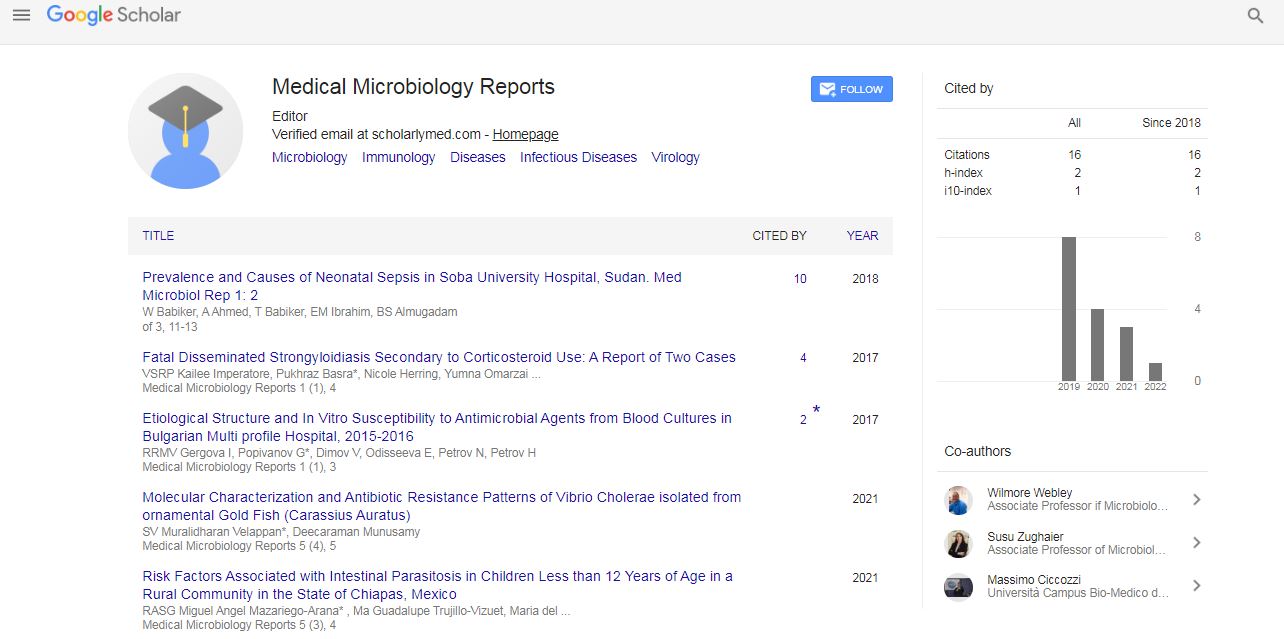Opinion Article, Med Microbiol Rep Vol: 7 Issue: 4
Exploring Bacteriology through Microbiological Barriers
Charette Capraro*
1Department of Medicine, Boston University School of Medicine, Boston, United States of America
*Corresponding Author: Charette Capraro,
Department of Medicine, Boston University School of Medicine, Boston, United
States of America
E-mail: charcapra@bmc.org
Received date: 24 November, 2023, Manuscript No. MMR-24-128558;
Editor assigned date: 27 November, 2023, PreQC No. MMR-24-128558 (PQ);
Reviewed date: 11 December, 2023, QC No. MMR-24-128558;
Revised date: 18 December, 2023, Manuscript No. MMR-24-128558 (R);
Published date: 26 December, 2023, DOI: 10.4172/MMR.1000360
Citation: Capraro C (2023) Exploring Bacteriology through Microbiological Barriers. Med Microbiol Rep 7:4.
Description
In the tiny world of microbiology, the study of bacteria stands as a fundamental, providing profound inputs into the complexities of life at the microscopic level. Bacteriology, the branch of microbiology dedicated to understanding bacteria, serves as a gateway to know the enigmas of these microscopic creatures that play important roles in both health and disease. The bacteriology explores the classification, structure, genetics and ecological roles of bacteria. These microscopic entities, frequently disregarded in their ubiquity, wield immense influence on the planet's ecosystems, from the soil beneath the feet to the complex ecosystems within the surface. One significant barrier lies in the maximum diversity of bacterial species. Bacteria come in myriad shapes, sizes and metabolic functions, making the task of categorization a difficult one. From the spiral forms of spirochetes to the spherical clusters of Staphylococci, the bacterial kingdom exhibits a remarkable range. Deciphering this diversity demands a meticulous approach, often involving advanced techniques such as DNA sequencing and molecular analysis.
The second barrier involves the dynamic nature of bacterial populations. Bacteria reproduce at astonishing rates, sometimes dividing every few minutes. This rapid proliferation poses challenges in studying and understanding bacterial communities over time. The microbiological barrier here is not just the speed of reproduction but also the adaptability of bacteria to changing environments. This adaptability is facilitated by mechanisms like horizontal gene transfer, allowing bacteria to quickly acquire new traits and resist antibiotics. Discovering through this barrier requires sophisticated experimental designs and computational models that can capture the nuances of bacterial evolution. Furthermore, bacteriology confronts barriers in finding the role of bacteria in health and disease. While some bacteria are beneficial and essential for processes like digestion, others can be pathogens causing infections.
Understanding the meticulous equilibrium between the symbiotic and pathogenic aspects of bacteria necessitates the study of microbiomes, the communities of microorganisms inhabiting specific environments. Understanding the nuances of microbiomes, whether in the human gut or environmental niches, is important for analyzing the roles bacteria play in both maintaining and disrupting health. The microscope at bacterial cells, another barrier emerges the complex world of bacterial structures. Bacteria exhibit an array of cellular components, including cell walls, membranes and flagella, each serving unique functions. Exploring this barrier involves not only visualizing these structures but also understanding their molecular composition and how they contribute to bacterial physiology. Overcoming this barrier enhances the ability to develop customized interventions, such as antibiotics that disrupt specific bacterial structures.
Conclusion
Bacteriology also grapples with the challenge of elucidating the genetic composition of bacteria. The genome of bacteria is compact yet potent, containing the instructions for their survival and adaptation. The microbiological barrier lies in the understanding of the complex genetic codes embedded in bacterial DNA. Advances in genomics and bioinformatics have been instrumental in overcoming this barrier, allowing analysts to reveal the genetic blueprints of diverse bacterial species and gain inputs into their evolutionary history. Exploring bacteriology is an expedition that involves navigating through microbiological barriers at various levels. From the diversity of bacterial species to the dynamics of their populations and from their roles in health to the complexities of the structures and genetics, each barrier presents both challenges and opportunities for discovery. It is through the relentless pursuit of knowledge and the application of innovative technologies that people can continue to stretch the limits of bacteriology, illuminating the concealed world of microorganisms that shape the very foundation of life on Earth.
 Spanish
Spanish  Chinese
Chinese  Russian
Russian  German
German  French
French  Japanese
Japanese  Portuguese
Portuguese  Hindi
Hindi 
